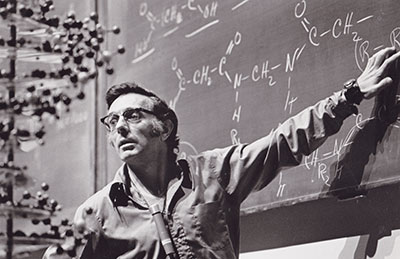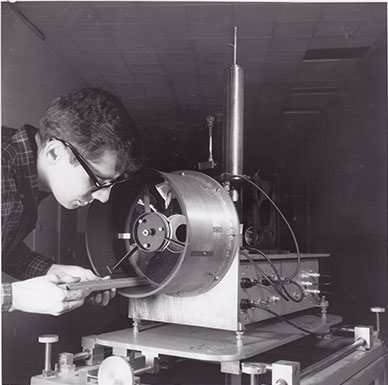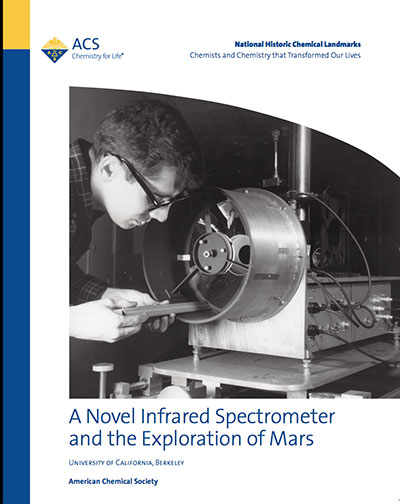Infrared Spectrometer and the Exploration of Mars
Dedicated at the University of California, Berkeley, on May 15, 2017.
As much as we know today about the planets of the solar system, it’s almost incomprehensible that a mere 50 years ago we knew almost nothing about them. Observations of even Mars and Venus, Earth’s closest planetary neighbors, through Earth-based telescopes had provided only the most rudimentary information on their physical characteristics and essentially no information on the chemical properties of the planets and their atmospheres.
That changed dramatically in mid-1969 when two identical National Aeronautics & Space Administration (NASA) spacecraft, Mariner 6 and 7, flew within a few thousand miles of Mars. Each spacecraft carried four instruments including an infrared (IR) spectrometer designed and built by a team in the College of Chemistry and the Space Sciences Lab at the University of California, Berkeley. (The other instruments were television cameras, an infrared radiometer and an ultraviolet spectrometer.) The team was led by chemistry professor George Pimentel (1922-89), with Kenneth Herr (1937-2015), who had received his Ph.D. in chemistry in 1964 working in Pimentel’s lab. The IR spectrometers were the first instruments, and remain among the few, to fly on a NASA mission that were built at a university rather than at NASA facilities or aerospace companies.
Among the spectrometers’ revolutionary findings were that the thin Martian atmosphere is made up almost entirely of carbon dioxide with trace amounts of water vapor, and that solid CO2 exists in the planet’s upper atmosphere. The IR spectrometers also detected solid water and water hydrates on the Martian surface as well as goethite,an oxidized oxyhydrate of iron that forms in aqueous weathering processes. This was the first evidence that there was once liquid water on the Martian surface.
Gazing at the Heavens
Humans have watched the night sky since prehistoric times. They noted the positions of stars and their movements with the seasons. They took particular note of a handful of the night sky’s denizens that moved independent of other stars and of each other. By the time of the Greeks and the Romans, these wandering celestial bodies had assumed the status of gods: Mercury, Venus, Mars, Jupiter and Saturn.
Astronomers have been charting Mars’ movements for more than 3,000 years. With the invention of the telescope, humans began to investigate the characteristics of the planets more deeply. In 1610 Galileo Galilei (1564-1642) became the first to observe Mars through a telescope. By the mid-19th century, the resolution of telescopes had become sufficient to decipher surface features on the planet. Observers thought they detected, among other features, “canals”—long, straight features that some thought were the product of intelligent beings.
Only a few years after the 1957 launch of Sputnik, the first artificial satellite to orbit Earth, space scientists in the U.S.S.R. and the U.S. began thinking of sending uncrewed spacecraft to Mars and Venus. These missions were intended to probe the features of these near neighbors more closely than any telescope could. Between 1960 and 1962, the Soviets launched five unsuccessful spacecraft to the red planet. The U.S. launched Mariner 3, its first attempt to fly near Mars, in 1964; however, the spacecraft’s solar panels failed to open, preventing its flyby. In 1967, Mariner 4 passed within 6,118 miles of the planet’s surface and provided the first close-up images of Mars. Mariner 6 and 7 were designed to follow up on that mission.
Mariner 6 and 7
The infrared spectrometers that flew on Mariner 6 and 7 had their genesis in a conversation between UC Berkeley’s Pimentel and Urner Liddel (1905-79), a long-time friend and mentor and a planetary science expert. Liddel was impressed with a rapid-scan IR spectrometer in Pimentel’s lab. An IR spectrometer measures the absorption of infrared radiation by a sample; the resulting IR spectrum is characteristic of the chemicals present in the sample. As Pimentel recalled in a 1989 interview with the American Chemical Society (ACS), Liddel said, “Look, if you can take an infrared spectrum in a millionth of a second, you ought to be able to tell us how to take an in- frared spectrum of the atmosphere of Mars.”
Pimentel noted in the interview that he was on a plane coming back from Washington, D.C., a couple of weeks later, and “I decided to spend the ride back trying to figure out how I would do it. I came up with a rather novel infrared spectrometer of a type that was not yet discovered.”
The spectrometer Pimentel envisioned used an interference filter as its dispersive element to generate the IR spectrum, rather than a prism or a grating. This approach simplified the spectrometer and made it feasible for such an instrument to be light enough to meet NASA’s 25 lb weight maximum. Pimentel and Herr won a grant from NASA in 1964 to develop a prototype, and in 1966 it was accepted for the Mars Mariner missions.
Pimentel, Herr, and their team at UC Berkeley designed and built the new IR spectrometer. Pimentel and Herr determined that the best wavelengths to be explored were in the 2–15-micron region, which would capture the reflected sunlight as well as the thermal emission from Mars. As chemists, they understood that fingerprints of several impor- tant molecules would be absorbing in these wavelengths. To utilize the most sensitive detectors—lead selenide and mercury-doped germanium (Hg-Ge) — in this region of the spectrum, an innovative and ef- fective cooling system was required, because the Hg-Ge detector needed to be cooled to within 22 degrees of absolute zero. The investigators decided to use a novel refrigeration unit employing a high-pressure gas system that would operate only during the 30-minute flybys of Mars. This decision would later cause anxious moments.

Tensions with NASA
The UC Berkeley group was a different bunch than the buttoned-down NASA bureaucrats were used to working with, and the relationship between them was sometimes rocky. As Jeanne Pimentel (b. 1935), George’s widow, put it in a 2000 article in The Chemical Intelligencer, “The starry-eyed recruits embarked on their mission, little realizing the difficulties they would encounter with their monolithic bosses, NASA and its contractor, Jet Propulsion Lab (JPL). ... Personality and mode of operation were partly responsible for the division, but at the heart of the matter was the approach to the scientific endeavor at hand. George and Ken were determined to push the state of the art of instrument design in order to get the best possible scientific results; NASA and JPL wanted a safer, less ambitious approach.”
Nevertheless, Mariner 6 and 7 were launched in February and March 1969 and reached Mars in late July and early August to examine different areas of the planet. Only a few days before Mariner 6 arrived at Mars, JPL lost contact with Mariner 7 and suspected that a rupture in the spectrometer’s high-pressure cooling tank was to blame. JPL regained contact with Mariner 7, but Pimentel and Herr wouldn’t know whether the spectrometer on Mariner 7 would function until the unit was turned on during the flyby. Their anxiety is evident in video record- ings made at JPL during the actual mission. Ultimately, the instruments on both spacecraft successfully scanned the atmospheric and surface chemistry of Mars.
“George and Ken were determined to push the state of the art of instrument design in order to get the best possible scientific results; NASA and JPL wanted a safer, less ambitious approach.”
— Jeanne Pimentel, The Chemical Intelligencer, 2000
Scientific Results
The novel chemical measurements carried out by the IR spectrometers included:
- The first evidence for solid CO2 in the Martian atmosphere.
- The determination of the composi- tion of the Martian atmosphere.
- The detection of solid water and water hydrates on the Martian surface.
- The determination of water vapor concentration in the Martian atmosphere.
- The detection of goethite, which forms in aqueous weathering processes, the first evidence that there was once liquid water on the Martian surface.
Both spacecraft transmitted their IR spectral data back to Earth, along with photos and data from the other scientific instruments. Because the actual encounters with Mars were so extraordinarily brief, Pimentel designed equipment for conduct- ing follow-up experiments back on Earth using the data in simulated space conditions, which verified and expanded the findings.
Rediscovery of the Spectrometer Tapes
Amazingly, the tapes containing the IR spectral data from Mars wound up socked away in a basement at UC Berkeley, and would have remained there were it not for the efforts of Laurel Kirkland (b. 1962), who in the mid-1990s was working on her Ph.D. in geophysics at Rice University. Kirkland was highly impressed by a spectrum of the Martian surface from one of the Mariner missions, and was stunned to discover that most of the data collected by the IR spectrometers were missing. She contacted Jeanne Pimentel, and the two of them eventually found the tapes. Through Kirkland’s efforts, the tapes were read and the data decoded with the help of Herr and other former members of the spectrometer team, who then went on to finish earlier draft papers and publish some new ones.
“The infrared spectrometer was a groundbreaking design of unprecedented sensitivity, mechanical stability, and environmental robustness, which enabled it to make the first chemical measurements of the makeup of the Mars surface and atmosphere.”
— Richard A. Mathies, chemistry professor, University of California, Berkeley, 2016
Landmark dedication and acknowledgments
Landmark dedication
The American Chemical Society (ACS) designated George Pimentel and Kenneth Herr’s design of a revolutionary infrared spectrometer as a National Historic Chemical Landmark (NHCL) in a ceremony at the University of Califor- nia, Berkeley, on May 15, 2017. The commemorative plaque reads:
In the 1960s, UC Berkeley’s George Pimentel and his team, including Kenneth Herr, developed a revolutionary infrared spectrometer at the university’s College of Chemistry and Space Sciences Laboratory. Two of these instruments flew past Mars aboard the Mariner 6 and 7 spacecraft in 1969. They sent back new data about the chemistry of Mars, including measurements of carbon dioxide, carbon monoxide, and water vapor in its atmosphere. Solid carbon dioxide and water ice were detected at the south polar cap, while vibrational signatures of iron oxyhydrates showed that liquid water once existed on Mars. The design and performance of these instruments set a new standard for spectroscopic studies of our solar system.
Acknowledgments
Adapted for the internet from "A Novel Infrared Spectrometer and the Exploration of Mars," produced by the American Chemical Society's National Historic Chemical Landmarks program in 2017.
Research resources
Further reading
- Chronology of Mars exploration
- Mariner 6 and 7 data sheet
- Mars Mariner Infrared (IR) Spectrometer Project Lead Personnel
Cite this page
American Chemical Society National Historic Chemical Landmarks. The Vitamin B Complex. http://www.acs.org/content/acs/en/education/whatischemistry/mars-infrared-spectrometer.html (accessed Month Day, Year).




